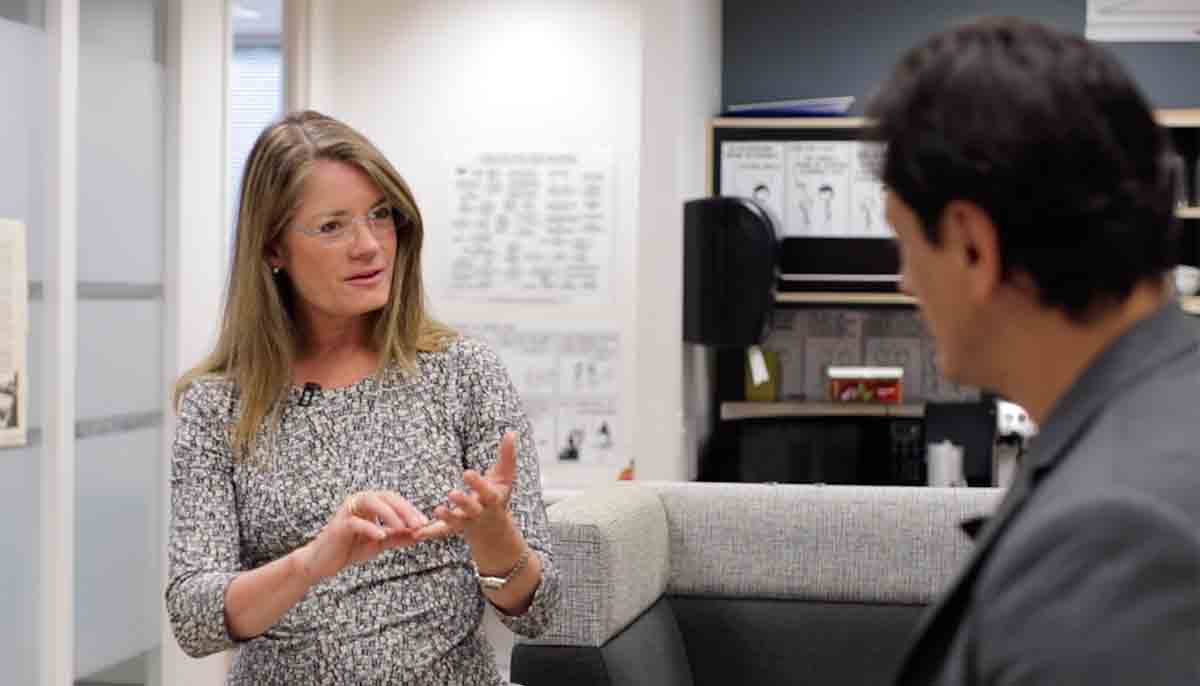America's got talent. But colleges don't know how to nurture it, and private companies just can't find it.
These problems persist in data science and analytics roles, which face an unprecedented shortage of qualified graduates. Eighty-two percent of organizations have positions that require data analysis skills, but an ongoing talent gap means finding suitable entry-level data scientists is a serious struggle.
Dr. Jennifer Priestley, Professor of Statistics and Data Science at Georgia's Kennesaw State University (KSU), thinks colleges that create career connections with data science companies can close that gap.
With 20 years of experience in academia and eleven in the private sector, she knows what she's talking about.
"I started working when I was six," she jokes.
Dr. Priestley has co-authored an incredible new book with Dr. Robert McGrath, Director of Programs in Health Data Science at the University of New Hampshire's College of Health and Human Sciences, that's been ten years in the making. It guides employers when hiring the data scientists of tomorrow and reskilling those already working in their organizations. The book is an executive's manual for finding the country's top analytics talent. It's a must-read for data science departments that want to promote better learning and career outcomes for their students.
The main takeaway?
Program directors and hiring managers that communicate, cooperate and collaborate are more successful than those that don't.
Just like data, colleges and organizations don't work well in silos.
Carlo Martinez, Steppingblocks Founder and CEO, talked to Dr. Priestley about solving the recruitment riddle stumping the data science and analytics sectors.
Table of Contents
1. The data science disconnect
3. Are data science and analytics companies too demanding?
4. What is a data scientist, anyway?
5. Dealing with these data science dilemmas
6. Data analytics programs require data (and lots of it)
The data science disconnect
Data science executives are scratching their heads. They're desperate for qualified graduates to fill entry-level positions, but colleges aren't producing enough of them. So the data science talent pool is becoming smaller, and more jobs are being left vacant.
There's a strange disconnect between colleges and data science companies right now. Recruiters require specific skills. Skills like math, modeling and machine learning. Skills like data ingestion, data replication and data manipulation.
But data science curricula don't always teach students these skills.
What gives?
A communication crisis
The problem is, primarily, a lack of communication between employers and data science program directors who are unplugged from the industry they once worked in. That's because the sector is evolving as fast as the algorithms that underpin it, and programs can't keep up with what the industry demands. By the time someone graduates from a data science program, coding grows more complex. Programming languages go obsolete. Today's technology becomes yesterday's. Then graduates learn they're not what organizations are looking for.
"Colleges need to work out what part of the talent gap they're trying to close," says Dr. Priestley. "If you're trying to train people to become scientists of data, your program needs to be affiliated with statistics and computer science, and those programs probably need to be housed in a college of computing, engineering or mathematics, with some area of application. If you want to train students to apply data science to an existing business problem, you need to affiliate your program with a business school."
Dr. Priestley says colleges run into trouble when they try to "do all things for all people," or when they go "very broad" or "very thin."
Her advice?
Pick a side (science of data or applied data analytics) then go deep.
It's better than going shallow.
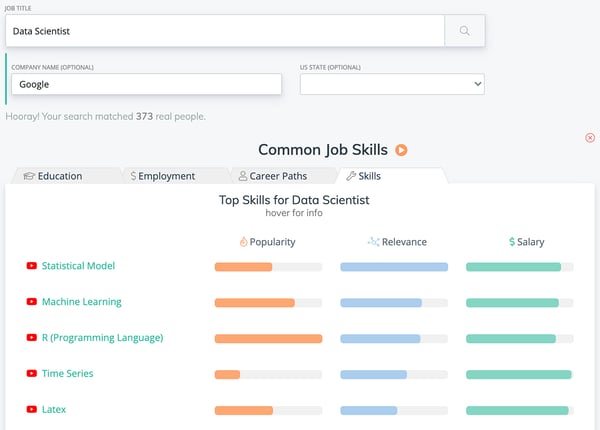 Top job skills for Data Scientists at Google. Sourced from Steppingblocks.
Top job skills for Data Scientists at Google. Sourced from Steppingblocks.
For example, take five of the most in-demand programming skills from data science companies, and see if the skills you supply the workforce match. Fifty-six percent of employers list positions with SQL as a requirement, not a request. Yet some colleges are churning out students with no SQL skills whatsoever, focusing on skills more affiliated with business or marketing programs. Some data science grads have no programming knowledge at all. No Hadoop. No Python. No Java. No nothing.
It's like a nursing grad that never learned how to check someone's vital signs.
It's not the fault of the institution. Far from it. Many data science companies don't communicate their requirements properly, so colleges can't update their programs accordingly.
Like a complicated line of code, things get lost in translation.
Other times, student success teams struggle to communicate the complexities of their data science courses. Who can blame them? Explaining the benefits of batch ETL or natural language processing (NLP) to a small business owner that doesn't even know how to code is a tough ask.
"Taking a very complex, very technical, very deep algorithm and trying to explain it to a client in nontechnical terms is difficult. That's an important skill in itself."
- Dr. Jennifer Priestley, Professor of Statistics and Data Science, Kennesaw State University
Colleges need to market both their programs and their students better. But they don't know how. And so data science companies get restless.
Students struggle with communication, too.
"We tell our doctoral students this all the time. You can go super deep in your ability to write these algorithms from scratch, but if you can't explain to somebody what you've done, or why it's relevant to what an organization is trying to accomplish, then what value are you creating?"
Dr. Priestley reiterates that communication is the only way to solve these problems. Colleges should reach out to hiring managers and vice versa.
"Employers should ask program directors if they have any 'shining stars' in their class they'd recommend. Or if they know a student who's trained in platform X. We get those kinds of questions all the time from local companies. If there's a very specific skill a recruiter's looking for, they should just reach out to the faculty member who teaches it."
Are data science and analytics companies too demanding?
Perhaps employers just expect graduates to create amazing visualizations or develop prototype models, but presuming graduates have the right skills in such a fast-changing industry is unrealistic, especially when those employers don't make it clear what they require.
Or maybe students expect employers to hire them because they think they have the required skills for a role.
"There can be a misalignment of expectations," says Dr. Priestley. "That's the person who took a boot camp in Python over the weekend and claims they're a data scientist, but they can't figure out why they didn't get the job."
So what do employers want? And how can students give it to them? Sometimes, it's almost impossible to tell.
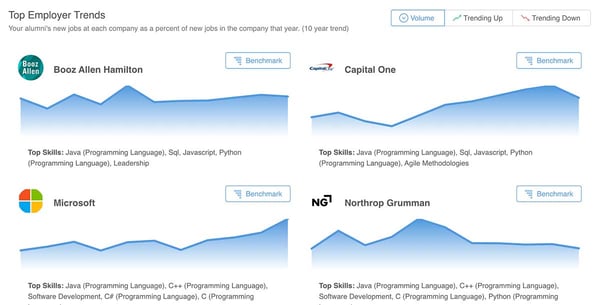 Understand hiring trends from your university. Sourced from Steppingblocks.
Understand hiring trends from your university. Sourced from Steppingblocks.
Dr. Priestley points out, that unlike with law or finance, there's no certification body in data science. No agency validates whether one has the correct skills.
"That muddies the waters a little bit, too."
That's why colleges and organizations should work together. They should communicate. Collaborate. Define data science. Curate curricula. And establish the skills required for the sector.
If an executive wants a graduate with feature extraction skills or knowledge of Extract, Transform, Load (ETL), they need to articulate these requirements.
But, just as crucially, data science departments need to listen.
Only then will the skills gap close.
Then data science departments can create fresh courses, professors can teach the right skills, and student success staff can prepare students for future career success.
Data-driven tools like those from Steppingblocks are at the heart of this "gap-closing." When colleges and private companies have access to data about students and then graduates, they can find the right person for the right job at the right time.
It's not rocket science. Just data science.
What is a Data Scientist, anyway?
Another problem is widening the disconnect between data science departments and the employers that want to hire graduates from them.
How do academia and the private sector characterize what a data scientist is? And how can colleges and employers curate curricula when this definition fluctuates depending on whom you ask?
"Somebody could have a degree in physics and call themselves a data scientist. But so could someone with a degree in psychology," says Dr. Priestley. "But the evolution of data science as an academic discipline has emerged in two types of programs."
Those programs, Dr. Priestley says, are:
1. Hub programs (left)
2. Spoke programs (right)
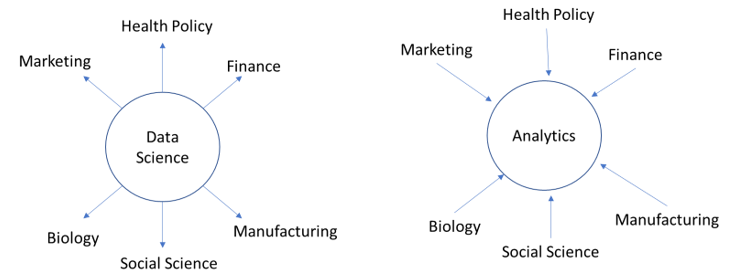 Hub programs serve somebody who wants to become a scientist of data — "someone who's truly application-agnostic," she adds. "Hubs" learn how to extract, transport, load, clean, model and interpret analytical output, working with data across an entire continuum. These students closely align themselves with math, statistics, pure science and all those subjects you'd commonly associate with data science being an interdisciplinary field. Hubs might pick up an application in finance or marketing or healthcare, or another discipline. These students are scientists of data, first and foremost, but have some area of application. Ultimately, they are "deep in the algorithms and even deeper in the programming," says Dr. Priestley.
Hub programs serve somebody who wants to become a scientist of data — "someone who's truly application-agnostic," she adds. "Hubs" learn how to extract, transport, load, clean, model and interpret analytical output, working with data across an entire continuum. These students closely align themselves with math, statistics, pure science and all those subjects you'd commonly associate with data science being an interdisciplinary field. Hubs might pick up an application in finance or marketing or healthcare, or another discipline. These students are scientists of data, first and foremost, but have some area of application. Ultimately, they are "deep in the algorithms and even deeper in the programming," says Dr. Priestley.
Spoke programs cater to those who have majored in something outside of data science, like psychology or business. Then they take a minor or concentration in data science and analytics. Students in these programs learn how to extract, transport, load, clean, model and interpret analytical output in their discipline. "Spokes" are not scientists of data but know how to perform basic data analysis and are probably more versed with point-and-click software than building complex data pipelines from scratch.
Neither of the above program types is better or worse, says Dr. Priestley. Just different. However, colleges often struggle to market a "data scientist" from these programs because the term means different things to different organizations.
All of this confusion stretches the skills gap and deepens the data science talent shortage.
Again, data-driven tools for career services, institutional reach and alumni relations clear up this confusion. When colleges and organizations access data about students from both hub and spoke programs, they can place graduates in the right roles and crack this data science-related conundrum.
Dealing with these data science dilemmas
There's only one solution for the analytics talent gap. Colleges should bridge the gap between data science departments and data science organizations through communication. When employers reach out to program directors and student success teams, they can recruit graduates directly. Then they can enroll current employees who need upskilling and reskilling in these same programs.
Problems solved.
"Once an employer works out what skills they need, they should contact the director of a school, or certainly the director of a program. But they should also reach out to individual faculty if a program teaches something very specific that's relevant to their hiring needs," adds Dr. Priestley.
Program directors can even bring in employers to give guest lectures. Or organizations can sponsor class projects.
"We've had great companies like Coca Cola and Home Depot come in and sponsor a project. The company comes in and gives us some nonconfidential data and students try to solve a particular data-related issue. They extract, transport, load and clean data and see an analytical project through from beginning to end. It's amazing to watch students from all these programs work together in a team and solve the problem."
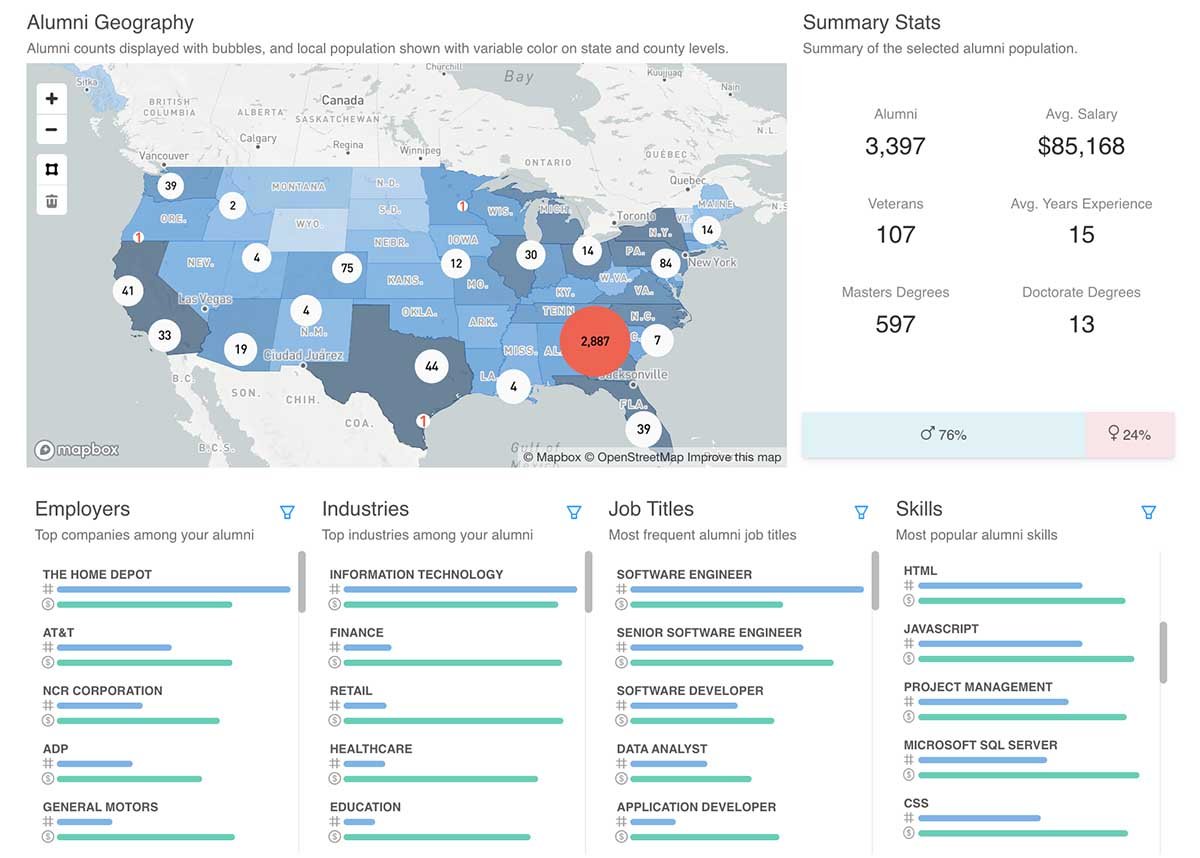 Learn where your alumni in IT work and invite those employers to campus.
Learn where your alumni in IT work and invite those employers to campus.
Colleges can also use data-driven programs to better communicate with hiring managers. Bespoke tools help program directors align curricula with industry demands and market students from hub and spoke programs to potential employers.
It's an investment that pays off.
With access to better data, colleges can train students to better fulfill the needs of employers, which can lead to higher salaries, better career prospects and increased job satisfaction, ultimately reflecting favorably on the institution itself. Data science departments can then increase enrollment, attract more funding opportunities and generate more profits from tuition. These benefits all come from better communication and the right data-driven tools.
A data-driven approach to career services and employer outreach is a win-win for everyone involved: the data science professor, the career services professional and the employer.
But, ultimately, the student.
Data analytics programs require data (and lots of it)
Colleges require data-driven tools to monitor industry trends, so they can adjust curricula, teach new skills and, eventually, drive student success by matching graduates with local employers.
But that's more difficult than it sounds.
"How do you bring real-world data in the classroom?" asks Dr. Priestley. "How do you start the conversation? How do you reach out to companies? And how do you explain what you're trying to do with data science in an academic environment?"
There's an answer to these questions.
For data-driven analytics programs to thrive, colleges need workforce and education outcome insights from an incredible range of sources.
Without these insights, the data science skills gap might become a skills gorge.
Below are some data sets colleges can use to address the talent shortage in data science.
Education data about degrees, learning institutions, graduation years, CIP categories and subcategories and more from:
- Resumes
- Online profiles
- Social media
- Government and education institution resources, such as the National Center for Education Statistics (NCES)
- College websites
- Public databases
- Institutional partnerships
Employment data about job types, job titles, the average length of employment and more from:
- Online profiles
- Social media
- Resumes
- Public filings
- Company websites
- Company firmographic databases
- Public salary databases
- Job postings
- Government sources, such as the Bureau of Labor Statistics (BLS)
Demographic data about gender, location, veteran status, job tenure, salaries and more from:
- Government sources
- Census data
- NCES graduation surveys
- Online articles
- Patent publications
- Proprietary assessments
- Online resumes
Institutional data about companies, educational institutions, industries, locations and more.
Using a combination of the data sets above can result in better learning and employment opportunities for students and bring colleges and employers closer together.
Final Word
Data science executives are looking for qualified college grads, but there's a tech talent gap that's causing a black hole. Dr. Priestley says colleges and employers should work together and solve the skills shortage that's damaging the data science and analytics sectors. The best way to do this? With data-driven tools that build bridges between data science students in both "hub" and "spoke" programs and the organizations that want to hire them. Only then can colleges adjust curricula, respond to industry trends and improve learning and career outcomes for the next generation of data scientists.
“Closing the Analytics Talent Gap: An Executive's Guide to Working with Universities,” by Dr. Jennifer Priestley and Dr. Robert McGrath is out now.
Looking for custom data that brings you closer to employers and solves the current skills shortage facing the data science and analytics sectors? Get your FREE employer trends report from Steppingblocks and learn how the right data-driven strategies improve student success.


.png)
